
Saxifragales is an order of angiosperms, or flowering plants, containing 15 botanical families and around 100 genera, with nearly 2,500 species. Of the 15 families, many are small, with eight of them being monotypic. The largest family is the Crassulaceae (stonecrops), a diverse group of mostly succulent plants, with about 35 genera. Saxifragales are found worldwide, primarily in temperate to subtropical zones, rarely being encountered growing wild in the tropics; however, many species are now cultivated throughout the world as knowledge of plant husbandry has improved. They can be found in a wide variety of environments, from deserts to fully aquatic habitats, with species adapted to alpine, forested or fully-aquatic habitats. Many are epiphytic or lithophytic, growing on exposed cliff faces, on trees or on rocks, and not requiring a highly organic or nutrient-dense substrate to thrive.
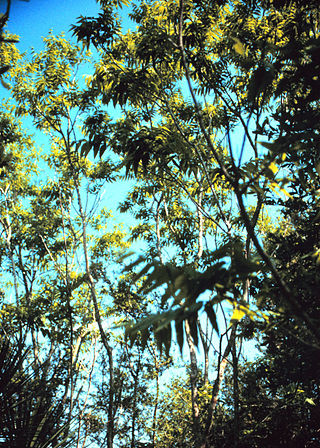
Sapindus is a genus of about thirteen species of shrubs and small trees in the lychee family, Sapindaceae and tribe Sapindeae. It is native to warm temperate to tropical regions of the world. The genus includes both deciduous and evergreen species. Members of the genus are commonly known as soapberries or soapnuts because the fruit pulp is used to make soap. The generic name is derived from the Latin words sapo, meaning "soap", and indicus, meaning "of India".
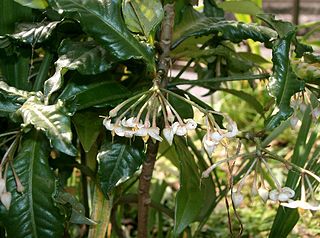
Ardisia is a genus of flowering plants in the family Primulaceae. It was in the former Myrsinaceae family now recognised as the myrsine sub-family Myrsinoideae. They are distributed in the Americas, Asia, Australia, and the Pacific Islands, mainly in the tropics. There are over 700 accepted species. One species, Ardisia japonica is one of the 50 fundamental herbs in traditional Chinese medicine.

Hibbertia scandens, sometimes known by the common names snake vine, climbing guinea flower and golden guinea vine, is a species of flowering plant in the family Dilleniaceae and is endemic to eastern Australia. It is climber or scrambler with lance-shaped or egg-shaped leaves with the narrower end towards the base, and yellow flowers with more than thirty stamens arranged around between three and seven glabrous carpels.

Alchornea glandulosa is a tree species of the Acalyphoideae native to South America, growing in southern Brazil from Minas Gerais to Rio Grande do Sul. It is locally known as tamanqueiro, tapiá or amor seco. This gnarled tree grows preferentially in riparian forest, where it a common pioneer species growing to a height of 10–20 m. It is essentially evergreen, though in the hot austral summer months there is a more pronounced changeover of leaves, and branches are denuded to some extent.

Mollinedia is a genus of flowering plants in the family Monimiaceae. There are 56 species distributed in the forests of the Neotropics, ranging from central Mexico to southern Brazil. They are mainly shrubs and trees.
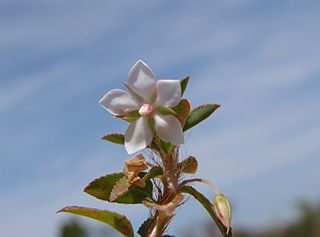
Sauvagesia is a genus of plants in the family Ochnaceae. It includes 49 species native to the tropical Americas, tropical Africa, and Madagascar.

Tetracera is a genus of flowering plants of the Dilleniaceae family native to the tropics. Several species are lianas.

Hibbertia hypericoides, commonly known as yellow buttercups, is a species of flowering plant in the family Dilleniaceae and is endemic to the south-west of Western Australia. It is usually a spreading shrub with linear to elliptic or egg-shaped leaves, and yellow flowers, usually with ten to fifteen stamens arranged in a cluster on one side of the two densely hairy carpels.
Klaus Kubitzki was a German botanist. He was Emeritus professor in the University of Hamburg, at the Herbarium Hamburgense. He is known for his work on the systematics and biogeography of the angiosperms, particularly those of the Neotropics, and also the floristic record of the Tertiary era. His plant systematic work is referred to as the Kubitzki system. He was a member of the American Society of Plant Taxonomists.

Ferdinandusa is a genus of flowering plants in the family Rubiaceae, native to the American tropics.

Doliocarpus is a genus of flowering plants in the family Dilleniaceae, native to Central and South America.
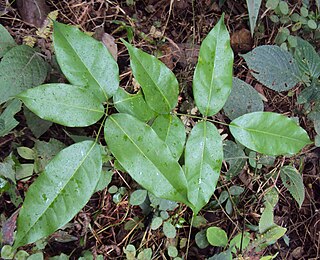
Rourea is a genus of plants in the family Connaraceae. They are found worldwide across the tropics and subtropics.
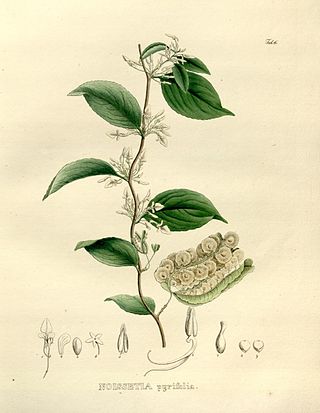
Anchietea is a genus of flowering plants in the violet family Violaceae, with six accepted species, found in tropical South America.

Luxemburgia is a genus of flowering plants belonging to the family Ochnaceae.

Pombalia Vand. is a genus of flowering plants belonging to the family Violaceae.















